The chile pepper is the fruit of plants from the genus Capsicum. When you see a scientific classification of a living thing, the first word, traditionally Latin, is the “genus.” The genus Capsicum contains 5 domesticated pepper species, a few semi-domesticated species and, over 30 wild pepper species. There are over 3,500 varieties of domesticated chile peppers. All peppers are members of the nightshade family, Solanaceae.
Genus Capsicum is native to the tropics of Central and South America.
All species of wild peppers have certain common characteristics: small, hot, red fruits that may be round, elongated, or conical and are attached to the plant in an upright position. The seeds of these fruits are dispersed by birds that are not affected by the heat.
When humans began to cultivate pepper plants they, selected seeds from peppers that where difficult to remove from the calyx so that birds could not pluck them. Larger, pendent (hanging down instead of upright) fruits became more desirable, and today most domesticated peppers have pendent fruits instead of erect. Each time larger fruits where selected, the size and weight increased, which caused the peppers to become pendents

Here’s a diagram to help visualize how the different chile species are related. Categorizing plants is intensely detail-oriented, and in case of peppers, it is almost a hopeless task. So, please consider the categorization used here only as a tool to have some clarity to the messy relationships between pepper plants. In the diagram below, 2n=24 means the plant has 24 chromosomes, and 2n=26 have 26.

I encourage you to visit pepperfriends.org for an abundance of information about wild peppers. Without their detailed research, this article would not have been possible.
First let’s discuss the domesticated species. These are the peppers that people most commonly know and grow.
Capsicum annuum (AN-yoo-um):
Includes many common varieties such as Bell peppers, Cayenne, and Jalapeños. Although the species name annuum means “annual” the plant is not an annual and in the absence of winter frosts can survive several seasons and grow into a sizeable perennial shrub. The single flowers are an off-white (sometimes purplish) color. The stem is densely branched and up to 60 centimeters (24 in) tall. The fruit may be green, yellow, or red when ripe. While the species can tolerate most climates, C. annuum is especially productive in warm and dry climates.
Capsicum baccatum (bah-COT-tum or bah-KAY-tum):
When speaking about baccatums, a majority of the time we are really talking about C. baccatum var. pendulum. These are Capsicum baccatums with fruits that hang down (pendant) instead of being upright and include South American Aji peppers, Peppadew, Lemon drop, Bishop’s Crown, and Brazilian Starfish. C. baccatum var. pendulum is the domesticated pepper of choice in Bolivia, Ecuador, Peru, and Chile. You can see in the diagram above, that baccatum has a subspecies called pendulum. So to break down C. baccatum var. pendulum, that means Capsicum baccatum, subspecies variety pendulum.
The fruit pods of the C. baccatum species have been cultivated into a wide variety of shapes and sizes, unlike other capsicum species, which tend to have a characteristic shape.
The earliest historical specimens of C. baccatum date to 2000 BC. Historical documents demonstrate the significance of the fruit in ancient Incan and earlier cultures. Contrary to the other four recognized domesticated Capsicum species, domesticated forms of C. baccatum are not commonly distributed outside South America.
Capsicum chinense (chi-NEN-see):
Some taxonomists consider them to be part of the species C. annuum, and they are a member of the C. annuum complex. In biology, a “complex” is a group of closely related species. C. chinense includes some of the hottest peppers such as the Naga, Habanero, Datil, and Scotch Bonnet. C. chinense is native to Central America, the Yucatan region, and the Caribbean islands. In warm climates such as these, it is a perennial and can last for several years. Within C. chinense, the appearance and characteristics of the plants can vary greatly. Varieties such as the well-known habaneros grow to form small, compact perennial bushes. The flowers, as with most Capsicum species, are small and white with five petals. When it develops, the fruit varies greatly in color and shape, with red, orange, and yellow being the most common, but colors such as brown are also known. Another similarity with other species would be shallow roots, which are very common.
Capsicum frutescens (froo-TESS-enz):
C. frutescens typically grow erect. They are usually tiny and hot and include Malagueta, Tabasco, Thai peppers, Piri Piri, and Malawian Kambuzii. The Capsicum frutescens species likely originated in South or Central America. It spread quickly throughout the tropical and subtropical regions in this area and still grows wild today. C. frutescens can be annual or short-lived perennial plants. Flowers are white with a greenish-white or greenish-yellow corolla. Fruit typically grows a pale yellow and matures to a bright red, but can also be other colors. C. frutescens has a smaller variety of shapes compared to other Capsicum species, likely because of the lack of human selection.
Capsicum pubescens (pew-BES-enz):
Includes the South American Rocoto peppers. The species name, pubescens, means hairy, which refers to the hairy leaves of this pepper plant. The hairiness of the leaves, along with the black seeds, distinguish this species from others. As they reach a relatively advanced age the roots lignify quickly (become woody by the deposition of lignin). They can take on an almost tree-like appearance and are sometimes called tree chili. These plants can live up to 15 years. Of all the domesticated species of peppers, this is the least widespread and systematically furthest away from all others. It is reproductively isolated from other species of the genus Capsicum. A very notable feature of this species is its ability to withstand cooler temperatures than other cultivated pepper plants, but cannot withstand frost
Now the wild pepper species:
Wild pepper species of chiles are the ancestors of all domesticated species. All species of wild peppers have certain common characteristics: small, hot, red fruits that may be round, elongated or conical and are attached to the plant in an upright position.
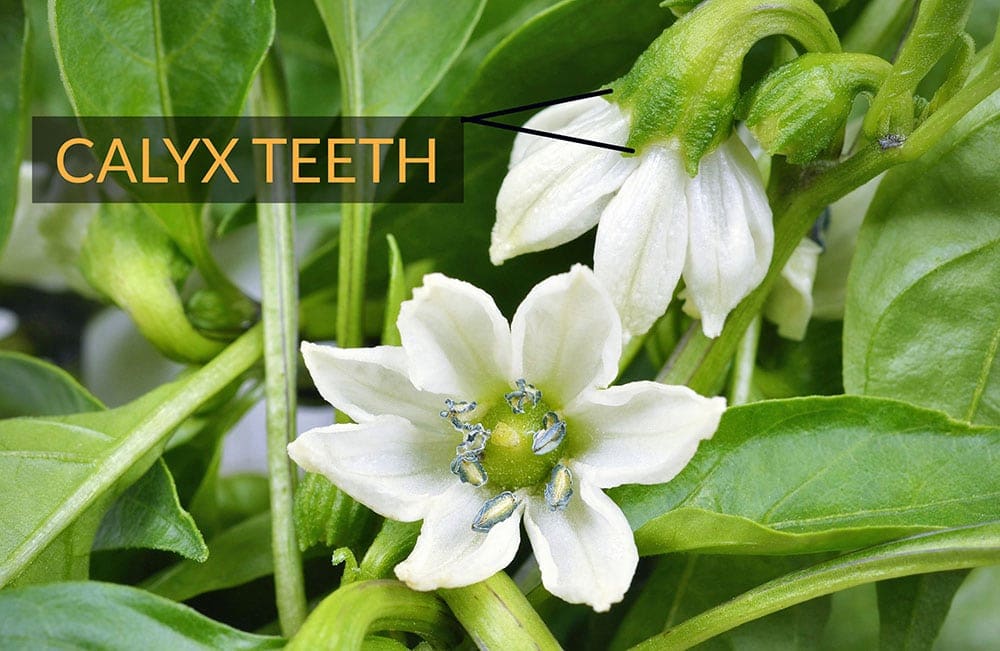
Uncertainties in the classification of wild peppers:
Although many of the wild peppers themselves look very similar, flower position, corolla color (together, all of the petals of a flower are called a corolla), calyx teeth, seed color, and pubescence (fine short hairs on the leaves and stems of plants) may differ from species to species. BUT traits such as corolla color and shape, number, length and shape of calyx teeth are variable depending on climate and growing conditions as well, even within the same population or in the same plant; thus sometimes it’s difficult to determine to which species belongs a certain population. Some populations found in different locations and classified as distinct species show minor differences and could belong to the same species, with differences caused by environmental conditions.
For the wild peppers, I have color coded each Complex (in biology, a complex is a group of closely related species.). The colors match the species diagram above.
ANNUUM COMPLEX

Capsicum annuum var. glabriusculum: This is the grandmother of nearly all commercial hot & sweet peppers we know today. The plant itself is often large and lives long (sometimes 30 years).
Capsicum annuum var. glabriusculum is a variety of Capsicum annuum that is native to southern North America and northern South America. Common names include chiltepin, Indian pepper, chiltepe, and chile tepin, as well as turkey, bird’s eye, or simply bird peppers, due to their consumption and spread by wild birds.

Capsicum chacoense: Native to South America, the plant is known locally as ‘Tova’ or ‘Covincho’ in Paraguay, ‘ají putaparió’ in Argentina, and as ‘ají puta madre’ in Chile. The latter two are euphemisms related to its heat, often causing people to swear when eating it. Its seeds are generally spread by birds that eat the fruit and distribute it after it has been digested. Plants tend to produce lots of fruits each season and in warm areas can easily keep producing for four or five years. The plant’s leaves are large, flat, and roundish, with a point at the end. The plant branches evenly, forming a small to medium shrub in most cases. Flowers are typically white.

Capsicum galapagoense: A very rare, wild pepper found only in the Galapagos Islands. Known for its ornamental foliage as well as tiny, red, pea-sized fruits that are very hot. It is a shrubby plant that can grow 3-4 feet high with white flowers. Growth habit is similar to C. annuum. This species is noteworthy for its hairy, aromatic leaves. When someone touches the plant a strong perfume odor fills the room. For some reason, this fragrance isn’t around all the time and seems to depend on uncertain growing conditions. Perhaps the plant only uses the trick in blooming season, in order to attract more pollinators. The leaves generally remain small and the fruit resembles tepin peppers. Flowers are small, solid white, similar in appearance to standard C. annuum flowers.
BACCATUM COMPLEX
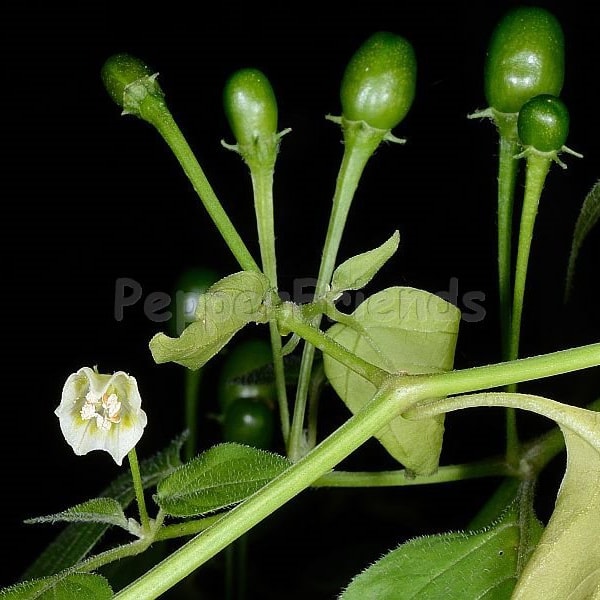
Capsicum baccatum var. baccatum: The wild grandmother of the “Aji” peppers of South America is a surprisingly humble, relatively small plant. Unlike the larger “Aji” baccatums, this plant is generally smaller. The leaves are typical to C. baccatum, light green, smooth, and sometimes a bit sticky. Its flowers are miniature versions of domesticated baccatum flowers, and the tiny fruits are very similar to wild annuum fruits.
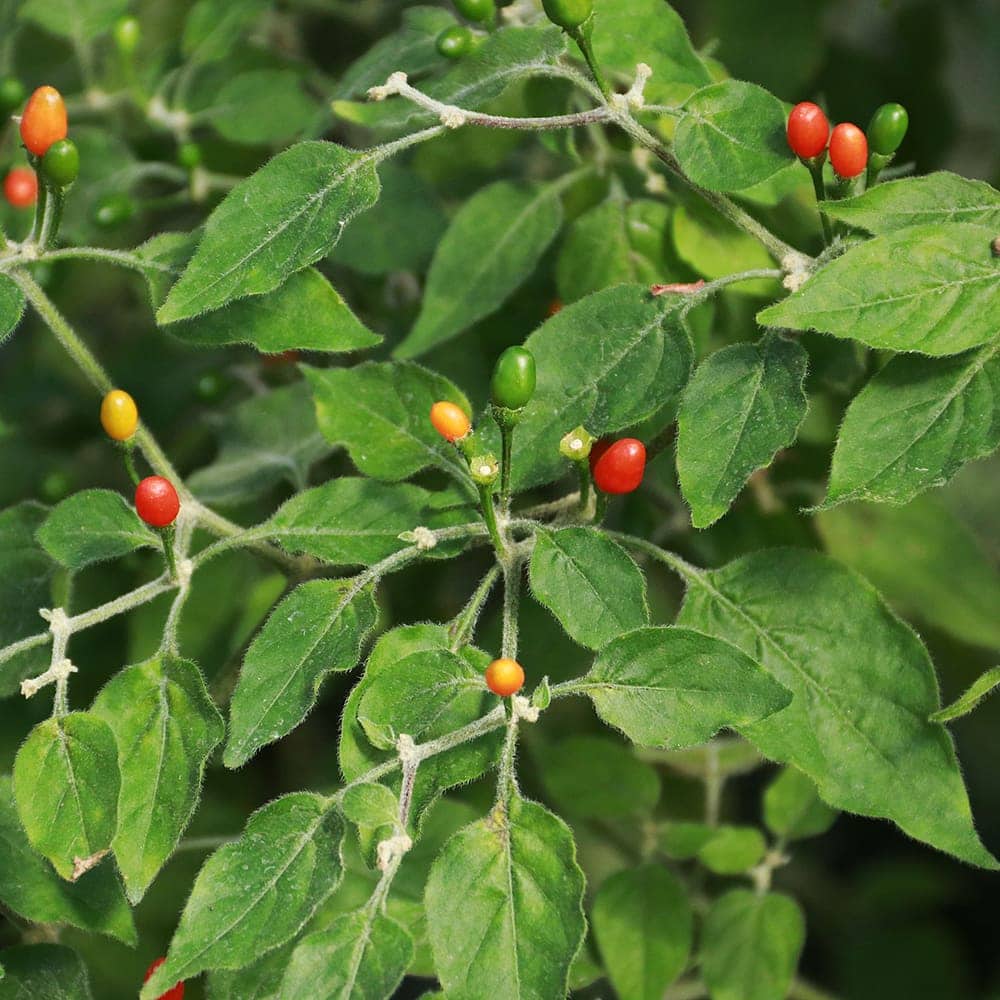
Capsicum baccatum var. praetermissum (pree-TER-miss-um): An uncommon plant, the small edible fruits are similar to the pequin and are quite hot. The leaves are larger than most of the common chile peppers. The small purple flowers often have yellow spots due to a single dominant gene. Fruits are typically about the size of a pea, though some plants can produce larger size fruits. Fruits ripen from green to orange-yellow and finally to red. This pepper enjoys humid and warm conditions.
Cumari Pollux is a Capsicum praetermissum, a wild chile variety from Brazil.

Capsicum baccatum var. umbilicatum: This rare variety of C. baccatum that I can find practically no reliable information on. It appears to grow in Bolivia, Paraguay, and Brazil areas both as cultivated and wild. I’ve seen the Chapeu de Frade pepper listed as Capsicum baccatum var. umbilicatum. But the Chapeu de Frade looks a lot like Bishop’s Crown peppers to me, which are Capsicum baccatum var. pendulum. I’m going to have to file this one in the ‘not sure’ category.

Capsicum tovarii: Named after Oscar Tovar who first discovered the plant in 1954 in the Rio Mantaro basin in south-central Peru and the province of Huancavelica Andahuaylas in the Andes Mountains of Peru. Tovari is one of the rarest capsicums grown by hobbyists. It’s also one of the smallest species in capsicum. Fruits are extraordinarily small, only 3-5mm, translucent green when raw, bright red when ripe. Its shiny leaves vary a lot in shape & size. Also known as ‘ Mukuru’ or Mucuru-uchu. Flowers are slightly yellow or yellow violet shades with green spots.
DIVE EVEN DEEPER: Use the Chrome browser to translate the site into English. https://www.pepperfriends.org/dbpf/capsicum-tovarii_001.asp
PUBESCENS COMPLEX

Capsicum eximium var. eximium: Native to a small area of Bolivia and Argentina, C. eximium has white to lavender flower petals. This species serves as a bridge with the species of the other two groups because of its crossing ability with C. baccatum and C. frutescens. It almost grows like a small tree. This pepper enjoys humid and warm conditions. These wild peppers are some of the slowest of all hot peppers to sprout. Germination is also erratic, with varying germination times for individual seeds in a single batch.

Capsicum eximium var. cardenasii: Found in La Paz, Bolivia, their native name is Ulupica. This is an interesting species with beautiful light green and purple flower petals and brown seeds. C. cardenasii develops small round red berries, sometimes referred to as chiltepins. Many wild Capsicums exhibit disease resistance of interest to plant breeders. C. cardenasii has been shown to be resistant to tobacco mosaic virus (TMV), and there is a possibility that one day this resistance may be transferred to other capsicum species through breeding.
“ANDEAN” CAPSICUMS
These plants are a mixed group with often very little known about them. All these plants are very rare and images are hard to find.

Capsicum caballeroi: Extremely rare and found only in a small range in Santa Cruz, Bolivia. A shrubby plant, bearing similarities to C. lanceolatum and reportedly growing up to 6-8 feet in height. The leaves are long for a pepper plant and come to a sharp point at their ends. The flowers are yellow, making this species, along with C. rhomboideum, one of the few yellow-flowered peppers. Fruits are tiny berries that ripen to red.
Capsicum ceratocalyx: Extremely rare and found in La Paz, Bolivia.

Capsicum dimorphum: Species with an unknown number of chromosomes spread to Colombia, Ecuador, and Peru at altitudes of 1800-3000 meters. The plants have a bushy habit and are very hairy. The leaves are arranged in opposite pairs of different shapes and sizes, some large oval coming to a point, the other small and round. The fruit is round, orange or red, and pendulous. The fruits are not spicy and the seeds are brown.

Capsicum flexuosum: The plant has shiny, kind of wax-coated, narrow, dark leaves. Small flowers with green or golden spots. The mature fruit of C. flexuosum are tiny berries about 7 mm long that ripen to red. It has very little heat and it is quite sweet, a unique trait among wild capsicums. Seeds are brown/black. This rare bridge-species between the Western and the Eastern capsicums has 24 chromosomes as almost all the Western species do. Still, it does have clear features of the ancient Eastern 26-chromosome group, such as almost non-spicy, pendant fruit, and dark seeds.

Capsicum geminifolium: Species with 26 chromosomes spread in Colombia, Ecuador, Peru at altitudes of 1500-3500 m. The plants are bushy with thin stems. The petals are united along their margins, white or yellowish with purple / brown spots in the throat and in the back of the petals. The fruit is round, orange to red, and pendulous. The seeds are brown and spiciness is not known. Images from different sources show variable characteristics and some peculiarities (such as the shape and arrangement of the leaves) that are similar to C. dimorphum (above). May also be called C. lycianthoides. Further field studies are needed for a better understanding of the relationships between these species.

Capsicum hookerianum: Common in South Ecuador and North Peru at altitudes of 100-800 m. They are bushy plants 1 to 3 m in height. Leaves are oval that come to a point. Like most wild peppers, the fruit is round, red when ripe. The seeds are brown and the spiciness is unknown. The species is similar to C. rhomboideum, but differs mainly due to the number of calyx teeth. This species has 10 evident teeth, sometimes 5 long and 5 shorter. The petals are yellowish without spots.

Capsicum parvifolium: Species with 24 chromosomes diffused in the coastal area in central Brazil (Piauì, Cearà, Rio Grande do Nord, Paraiba, Pernambuco, Bahia) and in Venezuela. The plant is a real tree with monopodial growth habits, meaning they grow upward from a single point. They add leaves to the top each year and the stem grows longer accordingly. It can reach a considerable size (over 5 meters). The leaves are leathery, not hairy. It has purple petals edged in white, cream-yellow in the throat, and in the tube. The fruit is roundish with a diameter of 9-10 mm. They ripen from dark green to orange-yellow. The seeds are dark brown and spiciness is medium.
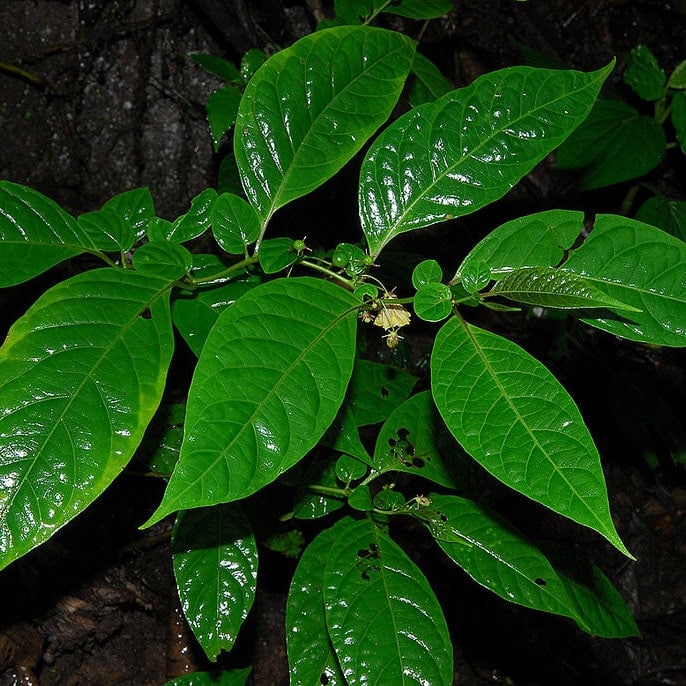
Capsicum scolnikianum: Common in Ecuador (El Oro) and Peru (Piura, San Miguel) at altitudes of about 1500-2000 m. The plant has a high bushy habit of 1 to 5 m. The calyx has 5 prominent teeth, that face backward on ripe fruit. The white-yellowish corolla (group of petals) are bell shaped. The fruit is round, erect, and red when ripe. The seeds are brown. It is unknown how spicy these peppers are.
ORIGINAL CAPSICUMS: 2n=26
Here’s where the named pepper species gets really muddy. Some of the named species are believed to be the same pepper, just given different names by different authors. These wild species of capsicum mostly grow in South-East Brazil’s Mata Atlántica zone. All or most of the species may have 26 chromosomes. None of them have been domesticated. Typical for these plants are pendant flowers, dark seeds, and yellow-green relatively (or entirely) non-spicy fruit.

Capsicum buforum: There is a lot of confusion regarding this species. Capsicum buforum may be the same as Capsicum mirabile (below), but not everyone agrees on this. This is a wild species found in the swampy areas of the Brazilian rain forests, first described in 1846 by A. T. Hunziker. A bushy plant that can reach heights between 1.5 ft and 10 ft. The dark green leaves are a narrow oval shape tapering to a point at the end. They develop 3-4 flowers per node with an upright posture. The flower has greenish-yellowish spots in the throat, purple-red spots in the lobes. The fruits have a spherical shape about the size of a pea. The spiciness is moderate. They have a pendulous growth (hanging down), maturing from light green to yellowish. The seeds are black.
DIVE EVEN DEEPER: Use the Chrome browser to translate the site into English. This in-depth research is on wild peppers of Brazil by botanists located there, so the site is in Spanish: https://www.pepperfriends.org/dbpf/capsicum-mirabile_001.asp

Capsicum campylopodium: This species may be a variation of C. schottianum. The most noticeable features are the flower has yellow spots, toothless calyx, and laterally compressed fruits. These characteristics are occasionally also present in C. schottianum and in nearly all places where C. campylopodium has been found C. schottianum has also been found.
The small, round fruits mature to yellow when ripe.
DIVE EVEN DEEPER: Use the Chrome browser to translate the site into English. This in-depth research is on wild peppers of Brazil by botanists located there, so the site is in Spanish: https://www.pepperfriends.org/dbpf/capsicum-campylopodium_001.asp
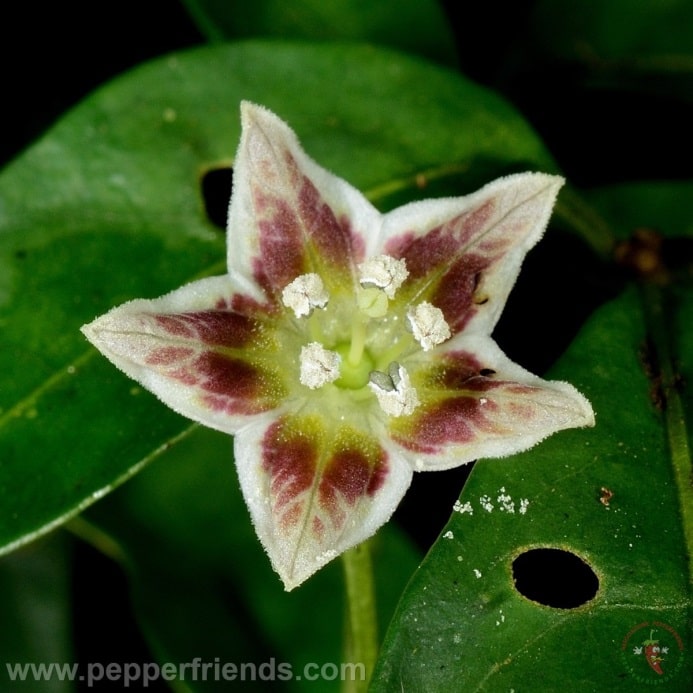
Capsicum mirabile: There is a lot of confusion regarding this species. Capsicum mirabile may be the same as Capsicum buforum, but not everyone agrees on this. Some populations of this species were initially described as Capsicum buforum Hunz., but the characteristics between the two species are very similar and the Capsicum mirabile nomenclature is correct because it was used first.
The Capsicum mirabile species is characterized by flowers with yellow-greenish spots in the throat and red-violet spots in the lobes of the petals, also visible on the back of the petal.
DIVE EVEN DEEPER: Use the Chrome browser to translate the site into English. This in-depth research is on wild peppers of Brazil by botanists located there, so the site is in Spanish: https://www.pepperfriends.org/dbpf/capsicum-mirabile_001.asp

Capsicum rhomboideum: Known also as Capsicum ciliatum (& witheringia ciliata), this is one of the most disputed species in capsicum. Due to its strange appearance, 13 chromosomes, yellow flowers, and lack of heat, C. rhomboideum has been thrown in and out of Genus Capsicum for decades, depending on what each particular researcher has believed to be fit. Most recent research by e.g. Hunziker, Barboza & Bianchetti has, however, finally placed this plant officially into the Genus Capsicum.
C. rhomboideum is considered a distant wild relative of the chile pepper. Its fruits do not have any heat. It gets its name from the rhomboidal to the elliptical shape of its leaves. It is native to Mexico, Central America, and the Andean region of South America. The flowers are yellow. The mature fruit of C. rhomboideum are pea-shaped and sized, bright red to black when fresh, and they darken as they dry. The seeds are brown.

Capsicum schottianum: The species C. schottianum, together with C. villosum, is most widely spread throughout southeast Brazil, between San Paolo and Rio de Janeiro, in mountainous areas, at altitudes between 500 and 1800 m.
The plants are easily recognizable due to their tree-like nature and lack of teeth at the calyx. The plants can reach a considerable size (up to 4 meters in height, with wide foliage) and in favorable conditions, they can be loaded with hundreds of fruits.
The flowers can vary greatly in color. The throat and the base of the petals have green or yellowish spots, while the middle part of the petals may have more or less diffused red-violet spots of various shapes. These spots may be present or not on the same plant, at different times of the year and with different weather conditions.
The fruit is round, about 6-8 mm, pendulous, more or less dark green from immature, yellowish when ripe. The seeds are black. The spiciness is moderate, greater in the immature fruits; the ripe fruits are rather sweet.






